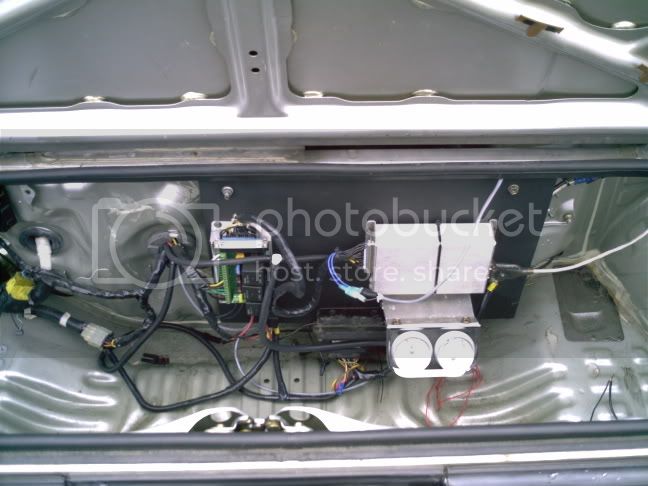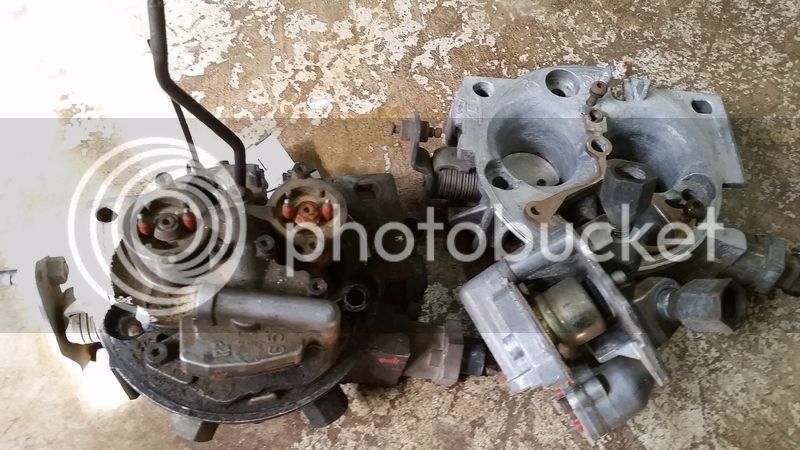Figured I would start a new thread as some may be interested. I personally wouldn't consider this 'hardcore' but I'm guessing some will, and what is difficult for some is easy for others. (Apparently getting a quadrajet to run right isn't so easy for me).
The vehicle - 71 frame/tub, long term project
Late 70s 350 4 bolt main, supposedly has cam, MSD dizzy, edelbrock intake.
TH350, stock transfercase
I was planning to swap in a GM TBI system I bought with a 305... however as it turns out, I simply can't easily retrofit the 1991 305 ecu into the 350 I have... I have some concern with the knock sensor, I'm missing the AIT sensor, some concerns with the VATS system in the ECM I have, and some concern with all the extra wiring/stuff that comes with the stock system.
I was also concerned with the down time that would be associated with trying to retrofit the system to an older 350 or having to swap in the 305.
I have experience with MS...
First experience I had was way back in about 2004 - I built a 1987 MR2 hardtop with a JDM 4AGZE, retained the supercharger, and went with MS1 PCB 2.2, with a relay board and EDIS4. It was great, except that the PCB2.2 has issues with low impedance injectors - and lo and behold, I blew injector fets from time to time. That was a fast and incredibly fun car. As far as I know I was the first to MS a 4agze and retain the SC (most guys went turbo back then... in fact the original MS & Spark was designed/built by a local MR2 guy).

Helped many others get their cars up on MS.
My second car on MS was... oddly enough... a 1987 MR2 (T-Top this time...
I've had 11 MR2s, only 2 1987s, both got MS). MS1 PCB3.0. Much more stable with the injectors. That motor was a 7AGE (technically doesn't exist... it was a small port 4age head with a 1.8L 7afe block, high compression 4age pistons... and was around 11.5:1).
Both vehicles were built with the engine and MS in mind - meaning neither were run on a computer with that engine other than MS.
After doing some reading I came across a post regarding MS and a TBI unit on an older 350 - what I liked about it, is that they discussed being able to install I steps - basically get the MS working, wire up to the tach and various sensors... but still running on the carb. Basically testing/tuning without any actual changes to the vacuum dizzy and carb.
To me, this means far less down time. Meaning, the MS will get built (I'll provide some photos when it arrives and what is entailed... I ordered the kit, an unassembled kit), then partially wired, then will get fuel, and when I'm ready, will swap the dizzy to have full electronic control.
This will be the first time I go MS without a relay board and without EDIS....
First step, once it arrives, will be to build the MS.
Next will be to install:
AIT (I have a spare Corolla unit)
CLT
O2 sensor
Wire in the tach
After that is all working I will:
Install the External Fuel pump (Carter P5001 on order)
Install the TBI (which will include injectors, IAC stepper motor, and TPS)
Fire it up
After that (and probably won't happen until winter) will be to get it up on spark control ad well. That may require a few configuration changes to MS and some down time.
I went this route because whether there's a 350, 305, or some day go back to an F motor (I've poked at the idea of a 1fx swap), the MS can handle it all with minimal changes.
The vehicle - 71 frame/tub, long term project
Late 70s 350 4 bolt main, supposedly has cam, MSD dizzy, edelbrock intake.
TH350, stock transfercase
I was planning to swap in a GM TBI system I bought with a 305... however as it turns out, I simply can't easily retrofit the 1991 305 ecu into the 350 I have... I have some concern with the knock sensor, I'm missing the AIT sensor, some concerns with the VATS system in the ECM I have, and some concern with all the extra wiring/stuff that comes with the stock system.
I was also concerned with the down time that would be associated with trying to retrofit the system to an older 350 or having to swap in the 305.
I have experience with MS...
First experience I had was way back in about 2004 - I built a 1987 MR2 hardtop with a JDM 4AGZE, retained the supercharger, and went with MS1 PCB 2.2, with a relay board and EDIS4. It was great, except that the PCB2.2 has issues with low impedance injectors - and lo and behold, I blew injector fets from time to time. That was a fast and incredibly fun car. As far as I know I was the first to MS a 4agze and retain the SC (most guys went turbo back then... in fact the original MS & Spark was designed/built by a local MR2 guy).

Helped many others get their cars up on MS.
My second car on MS was... oddly enough... a 1987 MR2 (T-Top this time...
I've had 11 MR2s, only 2 1987s, both got MS). MS1 PCB3.0. Much more stable with the injectors. That motor was a 7AGE (technically doesn't exist... it was a small port 4age head with a 1.8L 7afe block, high compression 4age pistons... and was around 11.5:1).
Both vehicles were built with the engine and MS in mind - meaning neither were run on a computer with that engine other than MS.
After doing some reading I came across a post regarding MS and a TBI unit on an older 350 - what I liked about it, is that they discussed being able to install I steps - basically get the MS working, wire up to the tach and various sensors... but still running on the carb. Basically testing/tuning without any actual changes to the vacuum dizzy and carb.
To me, this means far less down time. Meaning, the MS will get built (I'll provide some photos when it arrives and what is entailed... I ordered the kit, an unassembled kit), then partially wired, then will get fuel, and when I'm ready, will swap the dizzy to have full electronic control.
This will be the first time I go MS without a relay board and without EDIS....
First step, once it arrives, will be to build the MS.
Next will be to install:
AIT (I have a spare Corolla unit)
CLT
O2 sensor
Wire in the tach
After that is all working I will:
Install the External Fuel pump (Carter P5001 on order)
Install the TBI (which will include injectors, IAC stepper motor, and TPS)
Fire it up
After that (and probably won't happen until winter) will be to get it up on spark control ad well. That may require a few configuration changes to MS and some down time.
I went this route because whether there's a 350, 305, or some day go back to an F motor (I've poked at the idea of a 1fx swap), the MS can handle it all with minimal changes.













